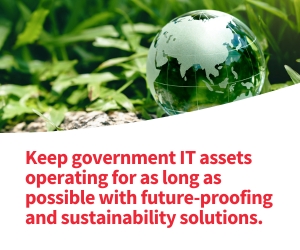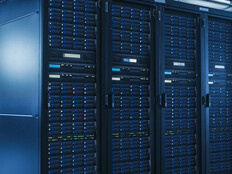Data center improvements “should be a key focus for every organization’s sustainability strategy,” says Jeremy Foster, senior vice president of Cisco Networking for compute. Upgrades can help reduce operating expenses and enhance resource use and optimization, minimizing waste and maximizing efficiency.
There are both public and regulatory forces pushing state and local agencies to make improvements.
“Many state and local governments are facing pressure from constituents to optimize operations and ensure reliability, all while enhancing sustainability. Many government leaders, including Michigan Gov. Gretchen Whitmer, have already signed legislation to enact clean energy standards,” says Vandana Singh, senior vice president of secure power at Schneider Electric, whose APC range of products deliver greater energy efficiency, fewer hazardous substances, and eco-friendly recycling and disposal options.
“Governments that endeavor to act on this should consider data center sustainability as a key method for improving overall efficiency,” Singh says.
READ MORE: These counties upgraded their on-premises data centers.
How Can Governments Make Cooling More Efficient?
Emerging technologies such as liquid cooling “help to meet the demands of modern computing, provide efficient heat removal, and enable closer component packing and greater compute capacity within the same footprint,” Foster says.
In addition, upgrading the software used to manage data center operations “can help reduce cooling by enabling constant monitoring and cooling algorithms to dynamically adjust power usage for optimal efficiency,” he says.
Overall, efforts to modernize data centers with more energy-efficient equipment can have an “enormous” impact, he says. “This is where industry serves as a key partner for global governments in the evolution and increasing use of data centers.”
Agencies can also look to improve cooling through economization strategies, Singh says. Such strategies “use ambient temperature to provide or supplement cooling requirements, which demands less energy.”
It’s also possible to reduce cooling demands with infrastructure upgrades. As an example, Freeman points to recent advancements in Dell’s Smart Cooling technology “that allow for more airflow through the systems than previous generations,” she says.
DISCOVER: Six questions to ask when collocating government data centers.
How Can Agencies Increase Energy Efficiency in Data Centers?
Data centers already run more efficiently than they did before. “With innovative designs, state-of-the-art technologies and sustainable equipment, data center computing has risen significantly in the past decade while energy consumption has risen only marginally,” Foster says.
But more can still be done, as agencies look to meet calls for net-zero operations.
Some best practices for energy efficiency include implementing more efficient hardware configurations, using effective device and power management tools, using renewable energy sources, and responsibly retiring old or obsolete systems, Freeman says. “In short, a sustainable data center uses energy-efficient technologies and rightsizing to optimize performance and reduce emissions,” she says.
Agencies can start by reviewing and improving the energy use of the existing components within their facilities. “From power supplies to cooling systems, governments should ensure that as much power as possible is directed toward computing work rather than being lost as waste heat,” Singh says. “Governments can accomplish this by deploying advanced, power-saving server technologies and adopting power management software that adjusts energy usage per workload.”
Foster points to several other key energy-savings strategies:
- Visibility: “IT teams must see their data center infrastructure to understand and tune performance, and to make adjustments, reductions and controls to optimize power savings,” he says.
- Control: “Being able to control individual power of the servers with policies and power management features such as energy-saving states and power-throttling controls will help deliver major energy-efficiency gains,” Foster says.
- Impact on Performance: As organizations manage their power infrastructure, he says, “they need to consider the performance trade-offs of certain infrastructure sustainability modes. As an example, IT needs to know the potential effect on workloads when infrastructure is set to a green mode where there could be a 20 percent increase in power efficiency but a performance reduction of 10 percent.”
At the end of the day, “it comes down to being able to see what your output is, control it through software and policy, and understand its impact on performance,” Foster says.
LEARN MORE: Here are three key approaches to data center automation.
What Does the Future Hold for Government Data Center Sustainability?
Technology innovations can help here. “For example, Cisco’s Silicon One is helping increase data center efficiency with a unifying architecture that provides the highest bandwidth in routing and switching, boosting performance and driving higher power efficiency alongside increased sustainability,” Foster says.
When it comes to data center infrastructure, legacy hardware often is “a key contributor to higher carbon footprints and energy waste,” Freeman says. By investing in modern solutions, especially those engineered for maximum efficiency, agencies can see “immediate results in data center energy bills while lowering an organization’s carbon footprint.”
Software also plays a role in improving energy efficiency. A modernized software stack “delivers the real-time data and controls needed to track and forecast energy and emissions and automate power and thermal management using telemetry data,” she says. “These insight tools can be seamlessly integrated through the stack, allowing agencies to easily identify and uncover any performance bottlenecks and take action to repurpose resources.”
Looking ahead, state and local governments are likely to put a stronger focus on data center sustainability. “We see broad acceptance and excitement about what sustainable data centers can bring globally, and we expect increasing investment and innovation in them,” Foster says.
EXPLORE: IT asset disposition helps companies improve sustainability.
New partnerships are emerging in support of this. “Deep collaboration and transparency between governments, industry, investors, communities and data center customers will help advance innovation while also driving sustainability,” he says.
With data center sustainability becoming an established priority for government, leading agencies will be those “that have a comprehensive sustainability strategy and use technologies to employ an active energy management approach,” Singh says.
As state and local governments look to adopt energy-efficient cooling technology in their data centers, they will need to keep pace with emerging solutions in this rapidly evolving field. “Innovation is creating efficiencies across governments’ adoption of energy-saving technologies and cost-effective resources and infrastructure,” Freeman says.
Agencies can also look to partner with vendors that have demonstrated a commitment to sustainable solutions.
They can team with brands and organizations that prioritize sustainability and ensure their products meet green standards, Singh says. “This approach does more than just check a box on a compliance checklist. It lays the groundwork for a holistic, sustainable IT strategy,” she says.











